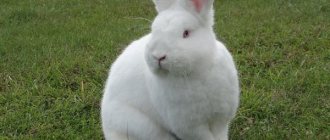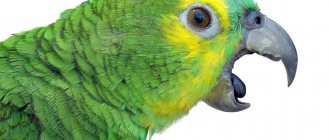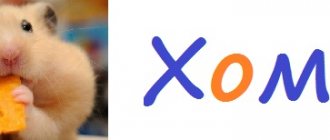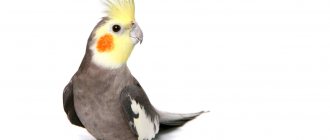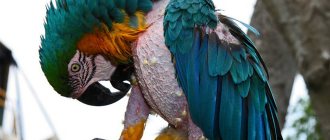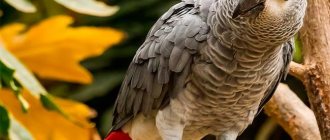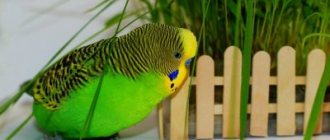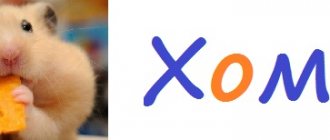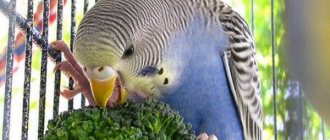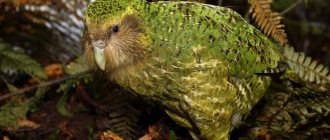- Wild animals
- >>
- Birds
The kea is a native New Zealand bird. It is also known as the New Zealand mountain parrot, which is the only true alpine parrot in the world. The kea was crowned New Zealand's bird of the year, with more thousands of votes cast for the species than there were surviving individuals. The kea is currently endangered.
Origin of the species and description
Photo: Kea
The kea (Nestor notabilis) is endemic to New Zealand's Southern Alps and is the world's only mountain parrot. These sociable and highly intelligent birds are well adapted to harsh environments. Unfortunately, the traits that the kea has evolved for survival, its curiosity and omnivorous appetite, have created conflict with humans over the last 150 years. Persecution and predation have severely depleted the kea population, and with only a few thousand birds left, the kea is a nationally endangered species.
Video: Kea
The kea is a large parrot with mostly olive green feathers, deepening to a deep blue at the tips of its wings. The undersides of the wings and the base of the tail have reddish-orange features. Female kea are slightly smaller than males and have shorter beaks.
Fun fact: Many other native birds in New Zealand do not fly, including the kea's relative, the kakapo. In contrast, kea can fly very well.
Their name is onomatopoeic, referring to their loud, high-pitched "keee-aaa" call. This is not the only noise they make - they also talk to each other more quietly, and the juveniles make various squeals and calls.
Keas are very smart birds. They learn impressive feeding skills from their parents and other older birds, and become very proficient with their beaks and talons. As their environment changed, kea learned to adapt. Keas are very curious and love to learn new things and solve puzzles. Recent research has shown how these intelligent birds can work as a team to achieve their goals.
References
- BirdLife International (2017). " Nestor notabilis
".
IUCN Red List of Threatened Species
.
2017
: e.T22684831A93048746.
Doi:10.2305/IUCN.UK.2016-3.RLTS.T22684831A93048746.en.CS1 maint: uses the authors parameter (site link)| date = / | doi = mismatch[ permanent dead link
] - Joseph, Leo; and others. (2012). "Revised nomenclature and classification of taxa of the parrot family group (Psittaciformes)" (PDF). Zootaxa
.
3205
: 26–40. - ^ a b c
Benham, W. B. (1906).
"Notes on the Tendency of the People of Kea to Eating Flesh ( Nestor Notabilis
)."
Transactions of the Royal Society of New Zealand
.
39
: 71–89. - keaconservation.co.nz Archived 9 October 2011 Wayback Machine: Kea Conservation Status.
- Lindsay, T., Morris, R. (2000) A Field Guide to New Zealand Wildlife
. Auckland: Harper Collins. (ISBN 1-86950-300-7) - ^ a b c
nhnz.tv, Kea the Mountain Parrot, NHNZ, one-hour documentary (1993). - stuff.co.nz
- Gould, J. (1856). About two new species of birds ( Nestor notabilis
and
Spatula variegata
) from the collection of Walter Mantell, Esq.
Transactions of the Zoological Society of London
, 94–95. - Simpson D.P. (1979). Cassell's Latin Dictionary
(5th ed.). London: Cassell Ltd., pp. 883. ISBN 0-304-52257-0. - Nga manu - birds, Te Ara - Encyclopedia of New Zealand
. Updated March 1, 2009. Retrieved January 21, 2010. - ^ a b c
Wright, T. F.;
Schirzinger E. E.; Matsumoto T.; Eberhard J. R.; Graves G. R.; Sanchez J. J.; Capelli S.; Muller H.; Scharpegge J.; Chambers G.K.; Fleisher, R. C. (2008). "Multilocus molecular phylogeny of parrots (Psittaciformes): support for a Gondwanan origin in the Cretaceous". Mol Biol Evol
.
25
(10):2141–2156. Doi:10.1093/molbev/msn160. PMC 2727385. PMID 18653733. - ^ a b c
Grant-Mackie, E. J.;
J. A. Grant-Mackie; WM Benefit; G.K. Chambers (2003). "The Evolution of New Zealand Parrots". New Zealand Science Teacher
.
103
. - Juniper, T., Parr, M. (1998) Parrots: A Guide to the Parrots of the World. New Haven, CT: Yale University Press (ISBN 0-300-07453-0)
- ^ a b
De Kloet, Rolf S.;
De Kloet, Sivo R. (September 2005). "Evolution of the spindle gene in birds: W and Z spindle gene intron sequence analysis reveals four major divisions of the Psittaciformes." Mol.
Phylogenet. Evol .
36
(3):706–21. Doi:10.1016/j.ympev.2005.03.013. PMID 16099384. - Schweizer, M.; Seehausen O; Guntert M; Hertwig S. T. (2009). "The evolutionary diversification of parrots supports a pulse model of the taxon with multiple transoceanic dispersal events and local radiation." Molecular phylogenetics and evolution
.
54
(3):984–94. Doi:10.1016/j.ympev.2009.08.021. PMID 19699808. - CRC Handbook of Avian Body Masses
John B. Dunning, Jr. (editor). CRC Press (1992), ISBN 978-0-8493-4258-5. - ^ a b
Forshaw, Joseph M. (2006).
Parrots of the world;
Identification Guide . Illustrated by Frank Knight. Princeton University Press. ISBN 0-691-09251-6. - Bond, A. B.; Wilson, K. J.; Diamond, J. (1991). "Sexual dimorphism in Kea Nestor notabilis". Emu
.
91
(1):12–19. Doi:10.1071/MU9910012. - Holdaway, R.N.; Worthy, T. (1993). "The first fossil record of kea on the North Island and a morphological and morphometric comparison of kea and kaka" (PDF). Notornis
.
40
(2): 95–108. - ^ a b c d
O.
Noted
. Retrieved May 8, 2022. - Anderson, R. (1986). "Keas for the fortress." Forest and bird
.
17
: 2–5. - ^ a b
Bond, A.;
Diamond, J. (1992). "Estimating the population of Kea in Arthur's Pass National Park." Notornis
.
39
: 151–160. - ^ a b
Diamond J, Bond A (1999) Kea. Bird of paradox. Evolution and behavior of the New Zealand parrot. Berkeley; Los Angeles, CA: University of California Press. (ISBN 0-520-21339-4) - Elliott, G., Kemp, J. (1999). Conservation ecology of Kea ( Nestor notabilis
) Archived May 13, 2010. Wayback Machine. Report. WWF New Zealand. - "Kea." DOC.govt.nz.
_ New Zealand Department of Conservation. Retrieved September 21, 2022. - Jackson, J. R. (1962). "Kea's Life" Canterbury Mountaineer
.
31
: 120–123. - ^ a b
Clark, C. M. H. (1970).
" Observations on the population, movements and diet of the island of Kea,
Nestor notabilis" (PDF).
Notornis
.
17
: 105–114. - Diamond, J.; Bond, A. (1989). "Note the long-lasting responsiveness of kea Nestor notabilis
to its mirror image" (PDF).
Journal of Avicultural 95(2)
. pp. 92–94. Archived from the original (PDF) on October 2, 2011. - Elliott, G.; Kemp, J. (1999), Conservation ecology of kea (
Nestor notabilis
)
, WWF New Zealand - Jackson, J. R. (1960). "Keas at Arthur's Pass" (PDF). Notornis
.
9
:39–58.[
permanent dead link
] - Falla, RA; Sibson, R. B.; Turbot, E.G. (1966), A Field Guide to the Birds of New Zealand
, Collins, London, ISBN 0-00-212022-4 - ^ a b
Akers, Keith and Orr-Walker, Tamsin (April 2009). "Kea Newsletter" (PDF). Kea Conservation Trust. Archived from the original (PDF) on June 2, 2010. - Christina Troup. Open Country Birds - Kea digging up a petrel chick Archived 17 October 2012 Wayback Machine, Te Ara - Encyclopedia of New Zealand
, Ministry of Culture and Heritage. Updated November 20, 2009. Retrieved January 22, 2010. - Gaydon, G.K.; Fijn, N.; Huber, L. (2006). "Limited diffusion of innovations in the wild parrot, kea ( Nestor notabilis
)."
Animal Cognition
.
9
(3): 173–181. doi:10.1007/s10071-006-0018-7. - Wallace, Alfred (1889). Darwinism
. London: Macmillan and Co., p. 75. - Potts, Thomas (1882) [from "Out in the Open" 1882]. "Kea, or mountain parrot." In Reeves, William Pember (Minister of Education) (ed.). New Zealand reader
. Wellington: Samuel Kostol, Government Printer (published 1895). pp. 81-90 - via New Zealand Electronic Text Collection (NZETC). - ^ a b c d
Marriner, G. R. (1906).
"Notes on the Natural History of Kea with Particular Reference to the Supposed Tendency to Kill Sheep." Transactions of the Royal Society of New Zealand
.
39
: 271–305. - Jackson, J. R. (1962). “Does kea attack sheep?” (PDF). Notornis
.
10
: 33–38. - ^ a b c d
Temple, Philip (1994).
"Kea: The Feisty Parrot." New Zealand Geographic
. No. 024. Auckland: Kowhai Media (Published October to December 1994). Retrieved January 13, 2022. - "The Clever Clown of the Mountains." University of Vienna - Faculty of Life Sciences, Department of Cognitive Biology. Archived from the original on November 2, 2011. Retrieved October 28, 2011.
- Cheeky parrot stole tourist's passport, ABC News, May 30, 2009. Retrieved January 22, 2010.
- "DOC's work with kea." Conservation Department.
- ^ a b
"Arthur's Pass neighbors at odds."
Press
. February 2, 2008. Retrieved October 8, 2011. - "Dead kea dumped at Arthur's Pass were shot." Press release from the conservation department.
- ^ a b
"Conflict between man and kea." Kea Conservation Trust website. Archived from the original on September 19, 2011. - Kin-Tuala, Kelly. "Nga manu - birds - Bird names." Encyclopedia of New Zealand
. Retrieved May 12, 2022. - "DF2014: Kea". Community Wiki
. Retrieved January 28, 2022. - "Birds of New Zealand | Collective nouns for birds (letters K)." nzbirds.com
. 2011. Retrieved May 11, 2011. - Marriner, G. R. (1907) Further information on Kea. Transactions of the Royal Society of New Zealand
, 40, 534–537 and plates XXXII-XXXIV. - Temple, P. (1996) The Book of Kea
. Auckland: Hodder Moa Beckett. (ISBN 0-340-600039) - Bloomberg, Simon (February 21, 2009). "Possums Destroy Kea in Nelson Lakes." Nelson Post
. Retrieved October 8, 2011. - “Nest cameras record attacks on keas.” Fairfax New Zealand
. NZPA. November 18, 2010. Retrieved November 18, 2010. - "Lead poisoning." Kea Conservation Trust. Archived from the original on September 1, 2010. Retrieved October 8, 2011.
- ^ a b
McLelland, JM.;
and others. (April 1996). "Kea (Nestor notabilis) Captive Management Plan and Management Guide" (PDF). Threatened Species Occasional Publication No. 9
. Conservation Department. Retrieved October 8, 2011. - Yule, Jennifer (2009). "Exposure to lead on Kea (Nestor Notabilis), Takahe (Porphyrio Hochstetteri) and Australian Harriers (Circus Approximans) in New Zealand" (PDF). Massey University. Retrieved October 8, 2011.
- "Curiosity is killing kea, study shows." Dominion Post
. April 22, 2009. Retrieved October 8, 2011. - "DOC Reviews 1,080 Post-Kea Extinction Use Cases." Dominion Post
. July 30, 2008. Retrieved October 8, 2011. - "Seven keas dead after 1080 jobs." Otago Daily Times
. September 12, 2011. Retrieved October 8, 2011. - Ibbotson, Lucy (20 September 2011). "Kea Gangs Hack Traps to Control Doc's Predators." Otago Daily Times
. Retrieved October 8, 2011. - Hitchmuff, Rod; Bull, Lee; Cromartie, Pam (2007). The New Zealand Threat Classification System lists 2005
(PDF). Wellington: Department of Conservation. ISBN 0-478-14128-9. - “Drivers have been urged to slow down on kea.” DOC.govt.nz.
_ New Zealand Department of Conservation. August 25, 2022. Retrieved September 21, 2022. - "Kea Database". keadatabase.nz
. Retrieved September 21, 2022. - "Kea | Nestor Notabilis | Kea Conservation Trust NZ.” Kea Conservation Trust
. Retrieved September 3, 2022.
Appearance and features
Photo: What kea looks like
The kea is a strong flying large parrot, about 48 cm long and weighing 0.8-1 kg, widely distributed in the mountains of the South Island of New Zealand. This bird has primarily olive green plumage with shiny orange under the wings and has a large, narrow, curved, grey-brown upper bill.
An adult kea looks like this:
- bronze-green upper parts;
- lower back dull red, extending to upper tail coverts;
- the feathers are edged with black, which gives the plumage a scaly appearance;
- the underside of the body is brownish-olive;
- the underwings are orange-red, with yellow and black stripes extending to the underside of the feathers;
- the outer feathers are blue and the lower feathers are dull yellow;
- head bronze-green;
- the beak is blackish with a long, arched upper jaw with a deep hook;
- eyes dark brown, with a thin yellow eye ring;
- paws and feet bluish-gray;
- the female is similar to the male, but has a shorter bill, less curved manus, and is smaller than the male.
Fun Fact: The kea's most common call is a long, loud, high-pitched cry that can sound like a broken "kee-ee-aa-aa" or a continuous "keeeeeeaaaa." The sound of young individuals is less stable tonally, it is more reminiscent of a loud scream or squeal.
Although kea are known for their vocal imitative abilities, they are rarely studied, and their function (including imitating sounds made by other species, or even inorganic sounds such as wind) has not been studied at all in parrots. The kea is a member of the oldest branch of the tree parrot family, the New Zealand parrots.
Fun Fact: Olive green birds are very intelligent and playful, earning them the nickname “clown of the mountains.” New Zealanders are no strangers to the birds' antics, which include opening trash cans to get greasy food, stealing items from wallets, damaging cars, and literally stopping traffic.
Re-adaptation of parrots
Before Europeans arrived on the island, the kea bird ate only insects and plants. Due to the lack of food familiar to parrots, they had to change their diet. This is how mammalian meat appeared on the birds’ menu, the consumption of which granted the green beasts the status of predators. Zoologists call this phenomenon re-adaptation. Fans of the theory of evolution argue that it was re-adaptation that forced freshwater animals to leave their habitat and begin life on land.
Although their appearance makes large parrots look like predators, they were not originally predators. Powerful claws and a sharp beak were given to nestors for the convenience of climbing trees and facilitating the extraction of insects from under stones and bark. Today, large New Zealand parrots use these “devices” to attack small livestock, in particular sheep.
Where does kea live?
Photo: Kea in New Zealand
Native to New Zealand, kea are a protected species and the only alpine parrots in the world - they are of particular interest to New Zealand. Kea are found only in the mountains of the South Island of New Zealand. Kea can be found in the mountains of the southern Alps, but they are more common on the western side. Kea can live 14.4 years in captivity. Life expectancy in the wild is not reported.
Kea live in high-slope forests, steep wooded valleys, steep mountains and forests on the edges of subalpine scrub, at altitudes ranging from 600 to 2000 meters. It may sometimes descend into lower valleys. In summer, kea live in high mountain bushes and alpine tundra. In autumn it moves to higher areas to eat berries. In winter it drops below the timber.
Interesting fact: Kea parrots prefer to spend their time on the ground, entertaining people with their jumping movements. However, when they are in flight, they show themselves to be excellent pilots.
Keas love to enter buildings by any means possible, even through chimneys. Once in the buildings, nothing is sacred, if it can be chewed they will try it.
What does kea eat?
Photo: Kea parrot
Keas are omnivores, feeding on a wide range of plant and animal foods. They forage in trees and scavenge shoots, fruit, leaves, nectar and seeds, dig into the soil for insect larvae and plant tubers (such as native orchids), and dig up rotten logs to search for larvae, especially in rimu forests and pine plantations.
Some kea prey on Hutton's petrel chicks in the Siward Kaikoura Range, and throughout their range they take carcasses of deer, chamois, tahr and sheep. Birds like to land on the backs of sheep and dig into their skin and muscles to get to the fat around the kidneys, which can lead to fatal septicemia. This behavior is not common, but was the reason why kea were persecuted for over a hundred years.
In fact, the kea can be a vicious bird in attacking any unattended sheep. It was this preference that helped lead the bird into a dangerous situation as farmers and shepherds decided to kill them in large numbers. Unfortunately for kea, their addiction to sheep fat put them on the endangered species list, with farmers shooting over 150,000 of them until the practice was banned in 1971.
Thus, kea are omnivores and feed on a wide range of plant and animal foods, such as:
- wood and plant products such as leaves, nectar, fruits, roots and seeds;
- beetles and larvae that they dig out of the ground or from rotten logs;
- other animals, including the chicks of other species such as the petrel, or the scavenger and sheep carcass.
Diet
The predator parrot feeds on raw sheep meat, stems, nuts, roots, worms, fruits, larvae, insects, does not disdain carrion, table waste, eats other people's eggs and chicks. At home, you can feed nuts, peanuts, fruits, roots, leaves, bugs, and midges. If the bird spends most of its time outside the cage, it hunts mosquitoes, midges, and cockroaches.
Features of character and lifestyle
Photo: Kea parrot in flight
Endemic to New Zealand, the extremely intelligent kea parrots impress with their boldness, curiosity and playfulness. These birds love to try new things. If you give them lunch, they will take from every plate and swallow from every cup, and after eating, all the dishes will definitely be thrown away.
Insatiably curious, charismatic and mischievous, kea are also hardy. They can tolerate a variety of temperatures and thrive on everything from berries, leaves, fruit and nectar to insects, roots and carrion (dead animals). They have also been known to scavenge food from people's garbage cans. In fact, kea are famous on South Island ski fields and tramp trails, where they are often described as bold, reckless and often downright destructive.
Keas tend to hang around alpine picnic areas and parking areas, partly because they are an easy source of unhealthy food, and partly because that's where they can get the most harm. Young kea in particular are natural children of their parents - they are curious and will make a play for any new toy. Residents and tourists alike tell stories of the infamous birds hanging from the roofs and hoods of their cars.
Fun fact: Keas are generally very sociable birds and do not do well in isolation and are therefore not kept as pets. They live for about 15 years, usually in groups of up to 15 people. Kea communicate with numerous types of vocalizations, as well as through posing.
Keas are diurnal, rising early in the morning to call and then foraging until late in the morning. They usually sleep in the middle of the day and begin to forage again in the evening, sometimes until nightfall, when they go to sleep on tree branches. The timing of these daily activities depends on the weather. Keas are quite intolerant of heat and spend more time roosting on hot days.
Kea is adaptable and can learn or create solutions to survive. They can examine and manipulate objects in their habitat, as well as destroy car accessories and other objects. These destructive and curious behaviors are considered by scientists to be aspects of play. Often seen playing with branches or stones, alone or in groups. Keas chase predators and intruders in groups if one bird in the group is threatened.
Behavior
The parrot got its name because of the sound it makes: “Kea, Kea!” The predator prefers to spend most of its time in flight. Every day it soars in the air, inspecting the territory, at the same time looking for prey. It is not recommended to hand feed a new parrot. Ornithologists have found that the parrot has an intelligence level on par with crows. They are able to repeat a person’s speech in the same intonation. Dirty animals are often kept at home. It is recommended to buy a small bird, it is easier to teach it to perform simple tricks, and it is possible to learn a short poem. The young parrot quickly begins to communicate and becomes attached to the owner.
The predatory parrot knows how to handle simple objects and easily manipulates sticks and twigs. Skills are aimed at obtaining food. The bird has an extraordinary mind, quick wit, and can open any container with its beak. Moves things from place to place, breaks nuts by throwing them on the ground, can throw a heavy object on a branch so that the fruits fall to the ground. The pet loves to improvise and surprise its owners with new approaches to prey and food. Logicality and an average level of intelligence help the parrot get used to its environment.
Social structure and reproduction
Photo: Male and female kea
Keas are polygamous. Males fight for hierarchy and dominance. These hierarchies are not linear. An adult male can dominate an adult, but a young male can also dominate an adult male. They live in family groups and feed in flocks of 30 to 40 birds, often in landfills.
Female kea parrots reach sexual maturity when they are about 3 years old, and males are about 4-5 years old. Male kea can mate with up to four females during the breeding season. Female kea usually lay a clutch of 3-4 eggs between July and January in nests built in rocky areas. Incubation takes 22-24 days, the chicks remain in the nest for another 3 months. The female incubates and feeds the young by belching.
Keas nest in burrows under logs, rocks and tree roots, and in cavities between boulders, and they can sometimes build nests for several years. They add plant material such as sticks, grasses, moss and lichens to the nests.
The male brings food to the female by feeding her by regurgitation near the nest. Peak fledging occurs between December and February, with an average of 1.6 chicks per nest. The bird leaves the nest to feed twice a day for about 1 hour at dawn and again at night, when the birds venture no further than 1 kilometer from the nest. When the young are about 1 month old, the male helps with feeding. The young remain in the nest for 10 to 13 weeks, after which they leave it.
Interesting fact: Keas usually lay one clutch per year. Females may also nest for several years in a row, but not all females do so every year.
Intellectual abilities
For decades now, New Zealanders have been practicing their ability to make a mechanism that would be beyond the power of a kea. So far to no avail. Parrots can distinguish colors and solve logical problems with dexterity. Experiments have shown that birds have surpassed primates in skills. Possessing excellent memory, once birds receive food from human hands, they take it for granted. Feeding kea is strictly prohibited.
Legends and rumors surround these amazing creatures, which is why today kea parrots continue to attract more and more tourists. If you liked the article or have something to add, then leave your comments and also join our VKontakte group.
Natural enemies of kea
Photo: New Zealand kea parrot
The stoat is the main predator of the kea, and cats also pose a serious threat when their populations make incursions into kea habitat. Possums are known to prey on kea and disturb nests, although they are not as serious a threat as stoats, and rats can sometimes be observed preying on kea eggs as well. Keas are especially vulnerable because they nest in holes in the ground that are easy to find and fall into.
Lead poisoning was a particularly dangerous threat to kea, as there were thousands of old buildings scattered around remote areas of the South Island that could poison inquisitive kea. The effects of lead poisoning on birds were catastrophic, including brain damage and death. An estimated 150,000 kea have been killed since the 1860s due to a government bounty introduced following conflict with sheep farmers.
Recent research by the Kea Conservation Trust found that two thirds of kea chicks never reach the fetal stage because their nests are on the ground and are eaten by stoats, rats and possums (which the New Zealand government has committed to eradicating by 2050).
The Department of Conservation and the Kea Conservation Trust continue to record intentional kea deaths each year (from gunshots, bludgeoning or human poisoning), although such incidents are believed to be under-reported.
Sheep hunting
Hunting sheep became a favorite pastime of predators. Parrots love to get fat from their skins. The bird chooses the weakest sheep, which lags behind the herd, then lands and hides in the grass to analyze the situation. If there is no person nearby, the bird jumps on the victim’s back, uses its beak to clear the skin of fur, and then eats away at the soft tissue. The animal is slowly dying. The time for hunting sheep begins when grass does not yet grow on the arable land.
Parrots have never eaten meat. But after the arrival of Europeans on the territory of New Zealand, agriculture began. The sheep pasture consumed all the greenery, dooming other inhabitants of the forests and steppes to starvation. Therefore, the struggle for survival began. The natural food chain has moved to another level. Now predators prefer to eat meat waste. Both females and males go hunting; the choice stops at the weak sheep.
Population and species status
Photo: What a kea parrot looks like
Unfortunately, it is difficult to obtain an accurate estimate of the current kea population as the bird has a fairly widespread distribution at low densities. However, it is estimated that there are between 1,000 and 5,000 of these birds in the area. The relatively small number of individual birds is the result of aggressive hunting in the past.
Keas used to prey on livestock such as sheep, creating a major problem for farmers in the area. As a result, New Zealand governments paid handsomely for the kea, with the understanding that the birds would be removed from farmland and thus cease to be a problem for farmers. Unfortunately, this has led to some hunters going into national parks where they were officially protected to hunt them and claim bounties.
The result was that about 150,000 birds were killed in about 100 years. The award was revoked in 1970, and the birds received full protection in 1986. Problem birds are now removed from farms by officials and relocated instead of being killed. The kea population appears to be stable, especially in national parks and various protected areas. But the species is classified as vulnerable and has a relatively limited habitat.
